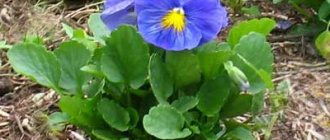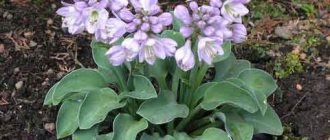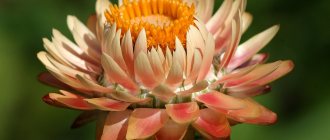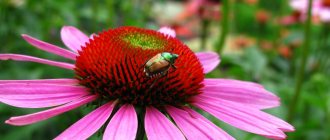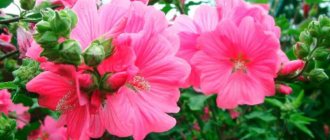Anyone who decides to experiment: growing blackberries from seeds needs to know some of the subtleties of this process. First of all, the seedlings will lose some of their maternal qualities. But new plants are even more resilient, which has been proven in practice. The second point is the longer development of seedlings: from 3 to 4 years pass before fruiting.
How to grow blackberries from seeds
Purchasing a seedling of the variety you like is problematic. Nurseries do not breed all varieties, and besides, they are expensive, ranging from 300-500 rubles. I decided to grow blackberries from seeds in my apartment.
Don't want to grow seedlings? Learn how to grow ripe strawberries at home.
When is the best time to plant
Blackberry seeds are sown in spring and autumn. There are pros and cons to both cases.
in spring
When planting in open ground.
Pros:
- good germination (80%);
- preliminary stratification (artificial hardening of seeds) is required.
Minuses:
- when planted in open ground, seedlings take a long time to awaken;
- sharp fluctuations in temperature affect the condition of the plant (spring frosts down to minus).
in autumn
When grown in pots or plastic containers indoors.
Pros:
- no hardening of seeds is required (natural process);
- simple care, watering, lighting with a fluorescent lamp;
- The sprouts appear strong and hardened.
Minuses:
- germination rate 8-10%
- more seeds are needed.
I chose autumn so that over the winter the seedlings would grow, become stronger and harden in a warm room. I didn’t have a goal to grow a lot of seedlings; 5-7 were enough. In addition, blackberries cannot be compared to watermelon in the amount of sweet kilograms; in addition, watermelons can easily be stored at home, find out how to do it correctly.
When is the best time to plant?
SpringAutumn
How to choose seeds
Friends, you can collect planting material yourself. Buy a shoot with ripe fruits at the berry market or ask your friends. I didn’t fool around, grind it, fill it with water, select seeds and dry it, I ordered it from an online store.
When I read the information about blackberry varieties, I chose Agave based on the following indicators:
- A proven producer, a long-cultivated species in the CIS and Russia.
- An upright bush, the shoots will not hang down and disturb the neighbors.
- The most winter-hardy variety (my frosts are down to 25-30 degrees).
- The height of the shoots is 3-5 meters (an excellent green fence on the balcony).
- Undemanding to soil, grows in soil with neutral reactions.
I ordered a package of Agavam seeds (20 pcs). When I received the package, I couldn’t wait to read the instructions:
- Soak the seeds in water for 5 days, change it every day.
- After 5 days, remove, mix with sawdust or damp sand in a plastic container, cover with plastic wrap and store in the refrigerator.
- Check the germination of planting material once a week.
- Before sowing in the spring, remove the seeds and rub each one with sandpaper.
The process is called artificial seed hardening. There are several ways to stratify based on time. For sowing in spring, choose artificial hardening. If you decide to plant in winter, natural preparation of seed material will do.
If you don’t want to harden the seeds, find out how to grow persimmons at home and you will always have something to surprise your friends.
Where is the best place to get seeds?
On the marketOn the Internet
Seed stratification before planting
There are three ways:
- Make depressions in the substrate and place each dry or pre-soaked seed in water.
- Mix the seeds with the substrate 1 to 3, then place in a plastic container, moisten and store in a cool place for 2.5 months. Check and water periodically.
- Soak cotton pads, put seeds in them, store in a cool place, and soak the pads in water once a week.
The last two methods are for cultivation in open ground in spring. My goal was to plant in the fall and grow a seedling in the apartment, so I simplified the process.
Soil preparation
First, I soaked the seeds in rainwater for 3 days. During this time I prepared sand, soil and peat. Mixed the components in equal proportions.
Landing rules
- I poured ⅓ of the prepared substrate into plastic cups (200 ml) and made shallow holes (4 mm) according to the number of seeds in the bag (20 pieces).
- I put one in each, sprinkled it, lightly sprayed it with water from a spray bottle and covered it with plastic wrap.
- I placed it in the room under phytolamps.
You can use this container for growing seedlings
Necessary care for young plants
- I removed the film and watered it once a week, then covered it again to create a humid microclimate.
- When the first shoots appeared, I added a little substrate to develop a strong root system.
- When 2 leaves have formed, remove the film, otherwise the first shoots will rot from excess moisture.
Friends, you can take a few berries from your friends, then get the planting material yourself. There is nothing complicated. Just be sure to ask what variety!
Care after landing
With the arrival of spring, beds with blackberry seeds sown in autumn should be covered with plastic wrap to prevent the possibility of frostbite.
During the summer months, seedlings need regular watering, as well as loosening the soil and applying fertilizer. With the arrival of autumn, night frosts return - during this period, beds with still immature blackberry bushes must be covered with non-woven material. The construction of a greenhouse during sowing saves the gardener from these troubles, but if the greenhouse is not heated, additional shelter will not hurt. It is recommended to mulch the row spaces in the beds with peat, humus or sawdust - this will protect the roots of the seedlings from exposure to low temperatures. In general, when constructing a winter shelter for blackberry bushes, you can take as a model the protective structures for rose bushes, which are also not highly resistant to winter frosts.
Next year you can start replanting the already strong blackberry bushes to a permanent place. Transplantation is carried out both in spring and autumn, depending on the region in which the site is located. The procedure for transplanting seedlings includes the same steps as planting cuttings or finished seedlings and necessarily requires the correct selection of the site and its pre-treatment. However, blackberry seedlings grown independently from seeds have an undeniable advantage - they can be replanted together with a ball of earth that protects their root system from damage. When replanting, you need to carefully remove the plant from the container or from the soil, being careful not to disturb the integrity of the earth clod, and replant it with it into the planting hole. Preserving a protective layer of soil around the roots not only reduces the risk of injury to blackberry root shoots, but also allows the seedlings to quickly adapt to a new location. Seedlings grown from seeds are more likely to take root on the site, quickly grow stronger and begin to bear fruit.
In general, seed sowing of blackberry seeds does not require special skills. For the success of this event, it is enough to follow the necessary recommendations. The correct choice of site and time for sowing is the main factor influencing the entire process of seed propagation of blackberries. Equally important is high-quality seed material. Despite the fact that growing blackberry bushes from seeds takes time, as a result, the gardener gets the opportunity to reap a large harvest from an entire blackberry plantation of his favorite variety.
What varieties of blackberries are suitable for growing at home?
There are the following types of blackberries: bush (dewberry), erect, climbing, with and without thorns. By ripening time early, middle and late. From the seeds presented in the table, seedlings of the following varieties are grown:
| Variety | Characteristic | pros | Minuses |
| Agawam | Mid-late species with thorns, erect shoots | Frost-resistant, productive, unpretentious, resilient, tender berries | Without pruning, the fruits are small, abundant shoots, aggressive growth |
| Black Natchez | Thornless, early ripening, erect bush | Productive, easy to care for, excellent tasting quality | Low winter hardiness, berries are baked at a temperature of +35 degrees, sunny side is not recommended |
| Polar | Frost-resistant, thornless, early, erect shoots | Abundant fruiting, early ripening, large berries | Shoots are hard and brittle, propagated by green cuttings |
| Guy | Thornless, erect bush, mid-early | High yield, frost-resistant, disease resistant | Moderately resistant to drought, propagated by cuttings |
| Prime-Ark Freedom 45 | Repairable, absolutely thornless appearance, harvesting up to two times | Shoots are smooth without thorns, average resistance to diseases | Low winter hardiness, cultivation in closed ground, fragile branches with berries, yield in greenhouse conditions |
| Thornfree | Late, thornless, half-spreading | High productivity, vitality, high adaptability | Late ripening of berries, does not tolerate dark places |
| Karaka Black | Shoots with thorns, typical dewberry | High yield, extended fruiting, decorative appearance | Low winter hardiness, extended fruiting |
Feeding
Standard organic fertilizers are suitable as fertilizing. You can also use saltpeter and urea to activate growth and ensure the viability of sprouts. They need to be taken in a volume of 15–20 g per square meter. There is no need to mix, just choose what suits your garden best.
Read also: Do they put onions on pizza?
But organic fertilizers will have to be spent much more. On average, it is recommended to use 5 kg per square meter, approximately once every 1.5–2 weeks. And an important clarification - if the basis of the fertilizer is manure, then using additional phosphorus is not necessary, or even harmful. There is enough of it in the manure itself, but an excess will lead to rotting.
If you need something to protect against bacteria and gray rot, then buy a sulfate layer with potassium as a base at the appropriate store. 50 g per square meter is enough, frequency of use is once a year.
How to grow blackberries on the balcony
Only 5 sprouts sprouted from the seeds I planted. It's time to transplant the strong seedlings into the ground and choose a container convenient for them. Friends, find out how to care for homemade blackberries.
Level up your level, grow not only blackberries, but also feijoas right at home, and I’ll tell you how!
What container should I plant it in?
It doesn’t matter what container you plant it in, but the more the better. Before removing the seedlings from the cups, I watered them well, then carefully removed the bushes and transplanted them, along with a lump of earth, into the prepared substrate.
Blackberry seedlings are ready to be transplanted onto the balcony
Soil requirements for growing at home
Blackberry is an unpretentious plant, there are no special requirements. In addition to soil with a pH of 5.5-7.0, it grows even in soil with a neutral reaction.
Mulching
So that the root does not suffer from the heat, I mulicify it with peat and mowed grass during flowering and fruiting. This layer retains moisture and weeds do not grow.
Watering rules
Blackberries love watering, but too much water leads to various fungal diseases. I water it 2 times a week. Then as the soil dries.
How often to replant
My friends, my seedlings took root well in the new place, I didn’t replant them anymore. Large bushes older than two years old do not acclimatize well to new conditions.
If you are tired of replanting blackberries, you can grow kiwi right at home and collect strange fruits from its vines.
Watch the video about what bushes I grew in plastic containers:
Autumn sowing
To sow a crop, you must first find a suitable site. It should be level, windless and sunny. You should not sow the plant in lowlands: stagnant water contributes to rotting of the roots. For the same reason, it is important that the soil is deeply drained.
Next, prepare the beds: remove weeds and increase fertility by digging up the soil with peat and humus. Then the soil is watered, furrows up to 15 mm deep are made, the crop is sown and sprinkled with soil.
In spring, blackberry beds are covered with film to prevent the crop from freezing. Further care is standard: watering, weeding, feeding, loosening.
Blackberries, the seeds of which were planted by the summer resident himself, will produce the first berries no earlier than after 3 years. Then it will become clear what the fruits of the new plant will be: small and sour or large and sweet. Therefore, it is important to prevent the bushes from growing throughout the garden before the first harvest is obtained. The temporary inconvenience of growing seedlings is justified by the long-term fruiting of the crop - for at least 10 years the plant will delight the summer resident with berries.
When and how to apply fertilizer when growing on a balcony
Blackberries require organic and inorganic fertilizers. Mineral compounds are added three times per season, organic matter more often. Before transplanting the seedlings into a large container, I combined the inorganic components with mullein. I added manure, superphosphate and potassium to the prepared substrate. I mix fertilizers in the following proportions: 5 kg of mullein, 150 g of superphosphate and 50 g of potash. Then I feed depending on the time of year:
- in spring - nitrogen at the rate of 50 g for each bush, urea;
- in summer - potassium salt, potassium sulfate, ash infusion, changing fertilizers throughout the season;
- in the fall - organic fertilizers (compost, manure, chicken droppings, ash) and potassium.
Author's note
Natalia Papanova
Blog author
Use the ash once every 2 years; be sure to sift the mullein through a sieve to get rid of mole crickets and other pests.
How to understand what blackberries are missing
Mineral deficiency is determined by the color of the leaves. Lack of nutrients affects the fruits; they become small and deformed and ripen poorly.
Which minerals are not enough:
- dry and brittle leaves and stems, slow growth of shoots - nitrogen and boron;
- brown and dried rims along the edges of the leaves, “curly” - potassium;
- slow growth, bronze tint, early loss of leaves - phosphorus;
- yellowing of young leaves - calcium;
- bronze shade – zinc;
- yellow color, fall in July – manganese;
- pale yellow color – gland;
- leaf fall ahead of schedule - magnesium.
Organic
Organic fertilizers are a natural complex. Chicken manure is especially valuable and contains a full range of minerals. Before feeding the plant, I dilute it with water in a ratio of 1 to 1. Then I carefully water it in the root system with a liquid solution.
Author's note
Natalia Papanova
Blog author
Do not use fresh raw materials; they must rot for at least 6 months.
Inorganic
Dear friends, feed your blackberries in the spring with sodium nitrate, urea, and ammonium sulfate. Apply potassium salt, potassium chloride, and superphosphate during flowering and fruit ripening. Dilute the granules in water and water or sprinkle them on the soil before irrigation. Inorganic fertilizers enhance the growth of green mass, strengthen the root system, and promote the formation of berries.
Author's note
Natalia Papanova
Blog author
Alternate complex mineral fertilizers with bird droppings, mullein, and ash.
Luxurious seedlings emerged thanks to organic soil fertilizers
Planting scheme
For spring sowing of blackberries, prepare a disinfected soil mixture consisting of sand, soil and peat based on the proportion of 1 x 1 x 1 cm. You can also add vermicompost according to the instructions on the package. Containers or plastic cups are filled with the finished substrate. The containers are filled one-third full so that during seedling growth soil can be added to form a good root system for the sprouts.
Experienced gardeners recommend using peat tablets; their composition and Ph reaction make them ideal for the development of young shoots.
Do blackberries have enough light when grown on a balcony?
Blackberries love a place well lit by the sun and protected from the winds. Optimally - south or south-west side.
From the north side
The shoots grow and stretch, the berries become smaller and lose their taste.
From the south side
My friends, blackberries love the sun, but the strong effect of ultraviolet rays is reflected on the fruits, they bake and dry out. Take this fact into account when choosing.
Lemon grown at home from a simple seed will also grow well on the warm southern side. This is beautiful and healthy, because lemons contain a lot of vitamin C.
How to organize additional lighting
- I placed all 5 containers with seedlings on a special stand and placed them on the closet shelf.
- I attached foil to the back wall with tape. It will act as a light reflector.
- The fluorescent tube was equipped with a height adjustment and bolted to the side walls at a height of 55-60 cm.
- I turn on the device 1 hour before dawn and 2 hours after dusk.
- 10-12 hours are enough for the development of a seedling in winter.
Features of cultivation in the regions
We can highlight the characteristic climate features for each region, which must be taken into account when growing blackberries. But within the same climatic conditions, there are differences in location (for example, the site is on a mountain, near a river or in a lowland). Other factors also influence the development of plants, such as shading, the location of buildings, prevailing winds, etc.
Blackberry culture in Belarus
In Belarus, two wild species of blackberries grow - gray (ozhina) and bramble - as well as many cultivated varieties. The flowering period here stretches from the end of June to the second half of July, and the ripening of berries begins no earlier than August. In order for blackberries of earlier varieties to ripen, it takes at least one and a half months, for later varieties - more than two months. Plants bear fruit better on the south or southwest side of the site, which is illuminated by the sun most of the day.
Garden blackberries bloom profusely and for a long time - almost until the end of July
The greatest harm to blackberries in this region is caused by the blackberry mite, and the most common disease is bush overgrowth.
Gallery: pests and diseases of Belarusian blackberries
The blackberry mite is a very small insect and can only be seen under a microscope.
Blackberries affected by mites are completely unsuitable for consumption.
Sprouting is a dangerous viral disease in which the shoots thin out and become dwarf
Growing blackberries in Ukraine
Blackberries are grown in large quantities in Ukraine. Local gardeners are more willing to choose late varieties that ripen in the very last days of summer. The region's berry harvest lasts throughout September. More than two hundred varieties of blackberries are widespread here.
The advantage of the crop is resistance to heat, which is especially important for the south of Ukraine. However, local gardeners consider the biggest drawback of blackberries to be poor winter hardiness. The climate of Ukraine is characterized by very low winter temperatures in some years. But even if the frosts are not severe, the cold winter winds pose a danger. In such conditions, blackberry plantings often freeze out, so the crop requires obligatory shelter.
Blackberries in the Moscow region
Gardeners in the Moscow region are experimenting with blackberry varieties with great interest. The blackberry variety Agavam is especially loved, as it can winter without problems even in the northern regions of the Moscow region.
The Agavam blackberry variety has proven itself to be reliable and resistant to cold weather.
In the absence of severe frosts, blackberries can winter well without shelter. However, given the climatic conditions of the Moscow region, you should not hope too much for a warm winter. New varieties Thorne Free and Black Satin must be covered for reliable wintering.
One of the main conditions for cultivating blackberries in gardens in the Moscow region is to place them in light and windless areas of the garden.
How to grow blackberries in Siberia
Blackberries are a southern berry, and they often miss the short Siberian summer. In addition, in Siberia, culture has difficulty surviving the cold period. When choosing a variety for cultivation in Siberian conditions, pay special attention to its frost resistance. The varieties best suited for the region are:
- El Dorado;
- Snyder;
- Eri.
The Erie blackberry variety is characterized by high yield and tolerates frosty winters very well.
The lowest temperature that blackberries can withstand without shelter is -22 °C.
Blackberry cultivation in the Urals
It is quite possible to get a large number of blackberries in the Urals if you choose the right variety. The largest blackberry harvest in the Urals comes from the following varieties:
- Polar;
- Ruben;
The blackberry variety Ruben is known for its frost resistance, but does not tolerate heat well.
- Black Satin.
The Ruben variety, bred only 6 years ago, deserves special attention. A bush with flexible branches, without sharp thorns, bears fruit before winter. But the main advantage is that in the conditions of the Ural region it is able to withstand low temperatures.
How to prune blackberries
The shoots do not have perennial wood; young growth grows from dormant buds underground. In creeping varieties they are long, in erect varieties they form an arc over time.
To form an upright plant
I have an upright blackberry bush; I prune it in the spring according to the following scheme:
- I installed a trellis on the balcony.
- I tied the young shoots to a wire, secured the old ones in the center, and removed the dry ones.
- I select the 8-10 strongest ones and cut off the rest.
- I shortened the young branches and placed them in the center in the shape of a sun.
For creeping blackberries
Friends, prune creeping shrubs in the spring. Remove damaged branches, select the 10 strongest ones, and remove the rest. For the winter, cut off the old shoots at the root, leaving 8-10 young shoots.
Watch the video, the opinion of an experienced specialist, on how to prune blackberries for the winter:
The most common mistakes
People who are unfamiliar with the blackberry growing process may make mistakes. The most common ones might look like this:
- Expectation of quick fruits. Remember - when grown from seeds, blackberries produce berries only three years after planting. Someone, confident in his success, can plant a large plot of blackberry seeds, expecting multiple rewards for his labors. Even with proper care, high-quality selection and preparation of seeds, it may happen that the fruits of the bushes will be small and bitter, and this will not go away over time. Thus, it turns out that the colossal work did not justify itself. It’s better to grow up to a dozen bushes, and then look at the result.
- Incorrect watering. In the first year of growth, you need to take care of abundant and regular watering. In the future, the bush should be watered in dry times or during the fruiting period, but the first year is critically important. Many novice gardeners have lost their harvest due to poor watering early in the blackberry's life cycle.
- Incorrect agricultural technology. Don't forget about cultivation, but don't overdo it either. Particular enthusiasm in this matter will lead to the death of plants.
- Unsuitable neighbors. Do not grow tomatoes or nightshades next to blackberries. This neighborhood only harms her.
- No fertilizers. Even if your soil is good, the sun is shining brightly and it rains regularly, you need to apply fertilizer to get a truly rich harvest.
Thus, having studied everything thoroughly and following the rules, it will not be difficult to grow blackberries from seeds. However, to enjoy a tasty harvest, the crop will require constant care.
Garden blackberries, unlike raspberries and strawberries, are not yet so popular in our summer cottages, and not every gardening farm grows this berry crop. Nurseries do not always have the right varieties, and seedlings are expensive, and when buying blackberries online, there is always a risk of getting something other than what you ordered. Because of this, it is difficult to acquire high-quality planting material and propagate blackberries in the required volume. However, if you set out to breed a variety you like, grow it from seeds - it’s cheap, not as labor-intensive as it might seem at first glance, interesting, exciting and always unexpected.
The most common diseases and pests of blackberries
Modern varieties and hybrids of blackberries have powerful resistance to diseases. Compliance with the rules of care and agricultural technology will ensure good shoot growth and yield. The cause of fungal diseases is increased soil moisture, the carrier of viruses is aphids and bud mites. The raspberry saber fly lays eggs at the base of the leaves, this leads to the death of the entire bush.
The mother shoot was damaged by saber fly larvae
Knowing how to deal with plant diseases, you can safely start growing kumquats at home, the citrus fruit will be grateful to you for your care
Fungal diseases and methods of combating them
- Among blackberry diseases, the most dangerous is rust. It covers the leaves with orange spots. If treatment is not started immediately, the bushes will die. For preventive purposes, I treat it with copper sulfate and Bordeaux mixture.
- Another manifestation of fungal spores is Anthracnose. The leaves are covered with grayish spots with purple edges. I spray with Fundazol three times in early spring.
- Didimella affects young buds and shoots. As a result, the bush dries out and dies. For the purpose of prevention, I treat it with Bordeaux mixture (2%).
- The consequence of powdery mildew is a white coating on the leaves. I spray it twice in early spring with a soda solution and add mullein to the soil at the rate of 1 kg per 10 liters of water.
Viral diseases and methods of combating them
Friends, curly hair, mosaic and ring spots cannot be treated. If the bush has stopped growing, the leaves are deformed, wrinkled and covered with yellow spots, immediately dispose of the diseased specimen.
Pests and methods of controlling them
I have seedlings growing on the balcony; the main danger is from insect parasites, aphids, bud mites, and raspberry saber flies. Pests drink the sap of the plant, and the fly larvae destroy the inner trunk of the shoot. For prevention purposes, I use insecticides twice a season in spring and autumn.
Comprehensive disease prevention
Dear friends, for prevention purposes, take the following measures:
- Check seedlings periodically for signs of disease.
- Control soil moisture; frequent watering causes fungal diseases.
- Sift the soil for the substrate through a special sieve to rid it of the larvae of small rodents.
- Treat the soil and bushes with antifungal drugs in the spring.
- Thin out the shoots, remove old ones and leave young ones.
Prevent blackberries to prevent rust on the leaves.
Sowing time
Blackberries may also appeal to someone because they can be grown in two seasons. The first is, of course, spring, but its seeds can also be planted in autumn. As with everything, each option has its pros and cons.
Read also: Making pies with cabbage
Spring
- The advantages include:
- the opportunity not to fear frosts, as in the fall;
- greater control over bush growth;
- the ability to use the “soaking” method to increase the percentage of blackberry germination;
- the cultivation process does not require special skills or additional funds.
- Now let's move on to the cons:
- seedlings may require additional lighting;
- if for some reason a plant needs to be transplanted, then the likelihood of its successful adaptation to a new place is not very high.
Autumn
- What are the advantages:
- the sprouts are strong and hardened;
- The state of the soil in autumn suggests natural stratification, which does not require wasting energy, as in spring.
- Disadvantages:
- frosts, because of them the entire crop can die, even if before that the growth went well and without failures.
How to propagate blackberries at home
Friends, the plant is propagated in spring, summer and autumn. Propagate upright bushes with root suckers and cuttings, and propagate the creeping variety with shoot tips, layering, root suckers and cuttings.
By layering
In the fall, dig a groove the length of the young shoot and bend it to the ground. Then sprinkle well and water.
If you love sweet berries, then find out how to grow blueberries at home directly from seeds and they will always delight you with their taste.
By shoots
Remove the growing point on the shoot, tear off the leaves, bend it to the ground and dig it down 5-10 cm. Next year a new bush will grow in this place.
Offspring
Dig up the root in the fall and cut it into several pieces 8-10 cm long. In the spring, bury them in the ground in a horizontal position. After 3 weeks, the first bushes will appear and need to be transplanted to a permanent place.
Green and root cuttings
In July, cut off the top part of the plant with several buds, leave the top 2 leaves, and remove the rest. Then plant the green cutting in a box with potting mix. Create a humid microclimate by covering with film. As soon as the first leaf emerges, remove the covering.
Dig up the root of the mother plant (main bush) in the fall, cut it into pieces and grow it at home (root cuttings method).
From seeds
Buy berries at the market or ask a neighbor. Then rub with your hands and fill with water. Good seeds will sink to the bottom, dull ones will end up at the top. Now drain the water and place it on a cotton cloth. Store planting material for no more than a year.
No thorns
Thornless blackberries can be propagated in any way. The only method they do not use is propagation by root layering. Separate the top of the shoot from above and place it in a container of water with the leaves facing down. A small bush will appear from the bud in three, maximum four weeks.
Watch a video on how to propagate blackberries:
How to collect blackberry seeds
If you like blackberries from your neighbors or at the market, ask for a few overripe ones. In autumn, bushes with berries are often sold at spontaneous markets so that the buyer can get a complete picture of the variety. You can buy one bush; before planting, the top part of the bush is still cut off, which means that the ripe berries can be used for seeds, and instead of one bush, in 3-4 years you will receive a large number of seedlings.
When picking berries, you need to make sure that the blackberry bush is not affected by pests or diseases.
So, to obtain planting material from berries, overripe fruits need to be mixed well so that the seeds are separated from the pulp. Rinse the resulting pulp with water several times until the largest, most mature specimens settle to the bottom, while the pulp fibers and pacifiers float to the top.
The seeds that have settled to the bottom should be scattered evenly onto cloth or paper and slightly dried in the shade.
Recently, many gardeners have begun to order blackberry seeds from China, however, there are no reviews of the successful production of seedlings from such planting material. Often, instead of blackberries, some weed sprouts that comes from the Middle Kingdom, but this is unlikely to give you any satisfaction. Pay attention to the appearance of such planting material; real blackberry seeds should look like the one shown in the picture below
Caring for blackberries in winter
Blackberry is a shrub with a two-year development cycle. Young shoots will bear fruit in the second year. Therefore, remove the old ones for the winter; you can recognize them by dried berries and flowers. They will not bear fruit next year. After trimming the plant, loosen the soil and water it, be sure to insulate it. Blackberries are frost-resistant, but severe frosts down to -30 will damage the shoots and buds.
Cover rules
- Cover the trunk roots with hay, leaves, corn or sunflower tops.
- Tear off the leaves, collect the shoots in a bunch, cover with agrofibre and secure with a rope.
- Bend climbing bushes to the ground, leave upright ones in the same position.
- Do not forget to create an air gap between the shoots and the heat-insulating material.
Loosening
Friends, after pruning, loosen the soil a little. Just do it carefully, the root system is located close, otherwise next year there will be a lot of growth.
Do I need to water
The blackberries have entered the dormant stage and sap flow has stopped. My container for blackberries is located behind the balcony; rain and melt water moisten the soil. Check the condition of the soil periodically; if it is very dry, water it.
How to trim
Friends, in the fall, leave 10-12 young shoots, do not touch the side shoots, remove only the old ones.
Preparing a blackberry bush for the winter
A few words about how to form bushes
Proper formation of bushes is a very important stage in caring for blackberries. This plant, especially in its creeping form, is very labor-intensive to process and harvest. Therefore, you can place blackberry bushes on a vertical trellis, this will make care much easier.
To construct a trellis, install poles 1.8 meters high at a distance of 6-10 meters from each other. Stretch the wire: the first row is at a height of 1 meter, the second - 1.2 m, the third - 1.5 m, the fourth - 1.8 m. You can limit yourself to two or three rows.
Thanks to the trellis, caring for blackberries will become simple and easy.
There are 3 ways to form a bush on a trellis.
- Intertwine the shoots between 1-3 rows of wire. Distribute the shoots that appear after shaping to the left and right of the main bush, bring the top branch onto the wire 4 rows.
- Spread the blackberry shoots in the shape of a fan and secure them to the wire. Place the healthiest and youngest shoots on the topmost wire. The bush will be better illuminated, which promotes free growth of branches.
- Spread the fruit shoots in different directions from the young shoots, tie them to the wire at a height of one and one and a half meters.
For garters, use twine, braid or ribbons made of soft fabric. Together with the garter, prune the shoots by about 10 cm to improve the harvest.
Pruning is done several times throughout the year. In autumn, completely remove diseased, fruit-bearing shoots and excess young shoots. In the spring you need to cut out frozen shoots. You will notice them immediately after buds appear on the branches.
Basic mistakes when growing blackberries
When cultivating blackberries, all beginners make the same mistakes. My dears, I give the following advice:
- Do not loosen the soil too much in the root system; blackberries produce a lot of growth.
- Do not use humus for winter feeding; mole crickets and other rodents lay offspring; it is better to use organic fertilizers.
- Do not bury the planting material too deeply into the ground, maximum 2 cm.
- Do not leave shoots without shelter in winter.
Watch the video on how to properly care for and grow blackberries
FAQ
Natalia Papanova
Blog author
Ask your question
Beginners are interested in many questions. I answer some of them:
What harvest can be harvested from a blackberry bush grown at home?
For me, one blackberry bush produces 5-7 kg per season, and seven beauties produce 30-35 kg.
How long can blackberries grow at home?
With proper care and fertilizing, blackberries can grow and bear fruit for up to 30 years.
How many years does blackberry grow before the first harvest?
Some varieties of blackberries take 3-5 years to grow before the first harvest. I had berries in the summer after planting an Agave seedling. Only the next year the young shoots began to bear fruit well.
Is it possible to take blackberry seeds from a summer cottage and plant them at home?
You can take blackberry seeds from friends or acquaintances' summer cottage and plant them indoors. Just find out which variety so you can properly care for it, prune it for the winter, and propagate it.
Reviews
Experience of planting Agawam blackberry seeds
I propagate many crops from seeds. I propagate blackberries this way because of the shortage and high cost of seedlings of the required varieties. I kept Agavem seeds in winter not in sand, but in damp cotton pads. I sprinkled seeds on one disk, covered it with another, and changed or moistened the disks every week. The seeds are clearly visible on the discs, making them easier to sow in the spring. Stored on the top shelf of the refrigerator door. I did not deliberately destroy the seed shell; in the warm spring, the strongest specimens hatched well, just what was needed.
I planted the seedlings along a blind fence, leaving it on the north side. For the winter, the seedlings were bent and covered.
Experience of planting blackberries Enchantress
Enchantress sowed dry blackberry seeds in the fall in a small container with a ready-made soil mixture, placed them at a distance of 1-1.5 cm from each other, 3-5 mm deep, covered with a tight lid, and stored in the refrigerator. In winter, I periodically moistened the soil. At the end of February, I placed this container in a warm place, covering it with a transparent lid. After two or three weeks, the first shoots began to appear. Germination was approximately 20%.
As practice shows, the technology for propagating blackberries with seeds is not much more complicated than growing tomato seedlings. You just need a little patience - after all, the sprouts will yield a harvest in 3-4 years, but they will bear fruit for at least 10-15 years. This prospect fully justifies the temporary inconvenience and hassle.
I will highlight the main thing
When growing blackberries, remember the following rules:
- Choose strong planting material.
- Familiarize yourself with the rules of agricultural technology for a particular variety.
- Make a trellis when the shoots reach 3-5 meters.
- Feed the plant in the fall with inorganic fertilizers, in the spring with chicken droppings, manure, and compost.
- Plant blackberry bushes at a distance of at least 2 meters.
Growing blackberries on the balcony is a fascinating activity that brings pleasure and beauty. Curly shoots hang from the balcony, bushy ones protect from the sun's rays. If you plant the remontant thornless Prime-Ark Freedom 45 in a pot, it will delight the owner with flowers and large berries. Just remember to remove all shoots for the winter.
Selecting a site and preparing the soil
To grow blackberries, it is advisable to use flat areas, protected from dry or cold winds, but sufficiently ventilated. The soil should be fertile, moist and deeply drained.
- Sandy soil or light loam works well. The optimal soil acidity for blackberries is 6-6.2 pH.
- Carbonate soils are not suitable for this crop. Blackberries will be deficient in magnesium and iron, which are essential for growth and fruiting.
- Clear the area under blackberries of weeds, take measures to destroy pathogens and pests.
- Before plowing the soil before planting, add rotted manure (1 bucket per 1 sq.m.), superphosphate (150 g/sq.m.), potassium sulfate (80 g/sq.m.). If the soil contains a large amount of humus, there is no need to apply manure. In such a plot, blackberries will grow well, but bear little fruit.
- The plowing depth for planting should be 40-50 cm; level the plowing before planting.
Blackberries can be planted:
- in the spring, before the buds begin to bloom;
- in the fall, before frost sets in.
Make sure that your seedlings have developed a root system and 1-2 stems with a bud on the roots.
To make further care of blackberry bushes easier, make an interval between furrows of at least 2 meters. The depth and width of the furrow is 30 cm.
Before planting, make sure that the seedlings are strong enough
If you are planting blackberries in the fall, first add aged manure or compost to the soil. In spring, it is enough to mulch the hole and the area around it. This should be done after the first watering, a week after planting.
Young. Trim newly planted plants to a height of 22-24 cm.
The following distances must be maintained between blackberry bushes:
- 0.75-1.5 m for erect varieties;
- 2.5-2.9 m for creeping varieties;
- on supporting structures the distance is halved;
- when grown by bush method, the planting scheme is 1.8 x 1.8 m.
You can adjust this data depending on varieties, placement and soil type.
Landing dates
Seeds are taken out of the refrigerator in late February or early March. From the moment of planting seeds to planting seedlings, it takes from 2 to 2.5 months.
If the option of obtaining seedlings at home is not suitable, you can use the method of natural stratification. To do this, the seeds are planted in a garden bed in late autumn, where they will be stored under natural conditions until spring, and then begin to grow . It should be noted that this method gives much lower germination, but at the same time the plants are more adapted to the climatic conditions of growth.
Pros and cons of spring planting
Advantages of growing seedlings in spring:
- when soaking seeds before planting, you can see how many of them have sprouted ;
It is convenient to germinate seeds on damp cotton pads.
Relative disadvantages include:
- the need to maintain a comfortable temperature for seeds for 2–3 winter months . If the lights in the house are often turned off and the refrigerator has to be defrosted, the seeds may rot;
- seedlings need a container and a place to grow, and in small apartments this becomes problematic;
- Transplanting seedlings into open ground is always stressful for the plant . In order for the seedlings to take root better, it is recommended to plant the seeds in peat cups, which are then placed in the hole along with the blackberries.
Preparing for landing
The collected seeds are not sown for germination in the same year. Nature has its own biorhythms and there is no need to disturb them, so the seed should lie in a damp, cool place for 2-3 months, for this it can be covered with a handful of raw sand, placed at the bottom of a small plastic container, and stored in the refrigerator at a temperature of 2-4 degrees, constantly maintaining sand moisture, this is called stratification.
Read also: Can you eat grape bones?
Do not store seeds for more than one year; they may rot when wet, and lose their viability when dry.
Before sowing, some gardeners practice scarification - when a part of the hard seed shell is carefully damaged with a sharp tool, this speeds up the awakening of the embryo.
The optimal soil temperature for germination is 25-28 degrees Celsius, so in the spring you should not plant directly in open ground; it is better to grow seedlings, which are then transferred to the site.
Seed stratification for spring sowing
Before germinating blackberry seeds, they are stratified. Seeds are hardened in different ways:
- Make depressions (3-4 mm) in the substrate, plant blackberry seeds and sprinkle. Then send it to a cool place for 1.5-2 months.
- Mix the seed with the substrate (1:3), distribute evenly in the container. Moisten and store in the cellar or refrigerator.
- Distribute the seeds on a cotton pad, put another on top, moisten and put in a cool place. As necessary, the discs are changed and additionally moistened.
Every 1-1.5 weeks, check the condition of the soil, watering as necessary and airing to prevent the substrate from rotting. After stratification, the containers are removed to a warm place.
Spring sowing and seedling care
The seeds are lowered into the prepared soil to a depth of 4-5 mm, keeping a distance of 3 cm between future plants, or placed in tablets. Then they are moistened, covered with polyethylene and provided with additional lighting.
Caring for seedlings consists of timely watering at intervals of 4-5 days and applying fertilizers every 1-1.5 weeks. When the seedlings have 4 leaves, they are planted in beds or in separate containers. The distance between plants is left 10-15 cm


